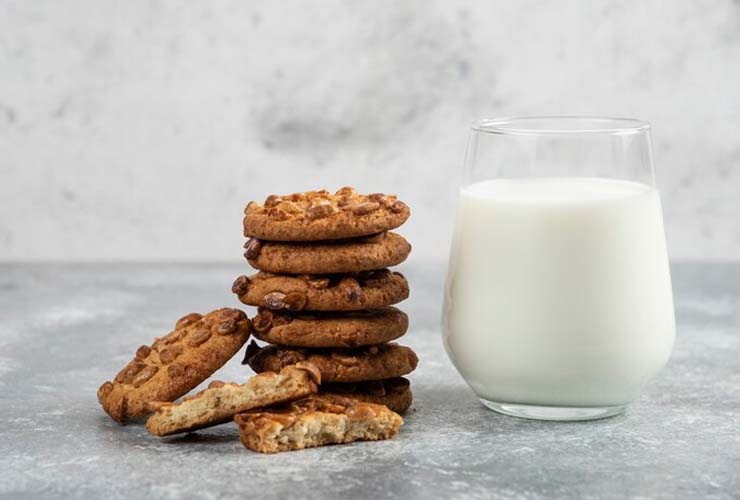Buttermilk: Nutrition, Benefits and Summer Recipes
May 1, 2023 | by Yashaswi Pathakamuri | Posted in Dairy, Nutrition Facts
Buttermilk is a tangy, slightly sour dairy product that is made by fermenting milk with lactic acid bacteria. Traditionally, buttermilk was the liquid that was left over after churning butter from cream. However, modern buttermilk is usually made by adding bacterial cultures to skimmed milk.
Buttermilk is low in fat and calories, making it a healthier alternative to cream or whole milk. It is also a good source of calcium, potassium, and vitamin B12. Its tangy flavor makes it a popular ingredient in baking, where it can be used to make biscuits, pancakes, and other baked goods. Buttermilk can also be used as a marinade for meats, as a base for salad dressings and sauces, or as a refreshing drink on its own or mixed with other ingredients like fruit.
Buttermilk can be found in most grocery stores, either in the dairy section or in the baking aisle as a dry powder that can be reconstituted with water. It is often used in Southern and Eastern European cuisines, but is also popular in many other parts of the world.
How’s Buttermilk Made?
Traditional buttermilk is made from the liquid that remains after churning butter from cream. This liquid is fermented naturally by the lactic acid bacteria that are present in the environment and in the milk.
To make buttermilk at home, follow these steps:
- Pour one cup of whole milk into a glass jar.
- Add one tablespoon of white vinegar or lemon juice to the milk.
- Stir the mixture together and let it sit at room temperature for about 10 minutes.
- After 10 minutes, the milk should have thickened and curdled, resembling the texture of traditional buttermilk.
- You can store homemade buttermilk in the refrigerator for up to two weeks.
Commercially produced buttermilk is made by adding lactic acid bacteria cultures to pasteurized skimmed milk. The milk is then allowed to ferment for several hours, which causes the lactose in the milk to be converted to lactic acid. This process thickens the milk and gives it its tangy flavor.
The resulting buttermilk can be used in a variety of recipes, from baked goods to marinades and dressings. It is also a popular drink in many parts of the world, where it is enjoyed for its refreshing flavor and health benefits.
How to Make Buttermilk From Curd?
Buttermilk can be made from curd by adding water and blending until it reaches a smooth consistency. Here’s how to make buttermilk from curd:
Ingredients:
- 1 cup of curd
- 1 cup of water
Instructions:
- In a blender, add 1 cup of curd and 1 cup of water.
- Blend on high speed for 30-60 seconds, or until the mixture becomes smooth and frothy.
- Pour the mixture into a container and let it sit at room temperature for several hours or overnight. This will allow the bacteria in the curd to ferment the mixture and create a tangy flavor.
- Once the mixture has thickened and become slightly tangy, refrigerate it until it’s chilled and ready to serve.
This method will produce a slightly thicker and creamier buttermilk than using regular milk, due to the natural thickness of the curd. The flavor will also be slightly tangy and sour, similar to traditional buttermilk. Buttermilk made from curd can be used in the same way as regular buttermilk, in baking, cooking, and as a refreshing drink on its own or mixed with other ingredients.
Nutrition
The nutritional value of buttermilk can vary depending on the brand and whether it is made from whole or low-fat milk.
Here are the approximate nutritional values for one cup (245 grams) of whole milk buttermilk:
- Calories: 157
- Fat: 8g
- Protein: 12g
- Carbohydrates: 12g
- Fiber: 0g
- Sugars: 12g
- Calcium: 285mg (28% of the Daily Value)
- Vitamin D: 24 IU (6% of the Daily Value)
Low-fat buttermilk will have fewer calories and less fat than whole milk buttermilk, but the protein and calcium content will be similar. Some varieties of buttermilk may also be fortified with additional vitamins and minerals.
It’s important to note that some commercially produced buttermilk may contain added sugars or flavorings, which can increase the calorie and sugar content. It’s important to read the label and choose a variety that fits your nutritional needs and preferences.
Is Buttermilk Good for Health?
Buttermilk can be a healthy addition to your diet, as it is low in fat and calories and contains important nutrients. Here are some of the health benefits of buttermilk:
- Good source of calcium: Buttermilk is a good source of calcium, which is important for strong bones and teeth.
- Low in fat: Buttermilk is lower in fat than whole milk, making it a good choice for those watching their fat intake.
- Probiotic properties: Buttermilk contains lactic acid bacteria, which are probiotics that can help improve digestion and boost the immune system.
- Helps with hydration: Buttermilk can help you stay hydrated, especially during hot weather, due to its high water content.
- Good source of protein: Buttermilk contains protein, which is important for building and repairing tissues in the body.
- Good source of vitamins: Buttermilk contains vitamins B12, riboflavin, and phosphorus, which are important for energy production and maintaining healthy bones and teeth.
However, it’s important to note that not all buttermilk is created equal. Some commercially produced buttermilk may contain added sugars, artificial flavors, or other additives. To reap the most health benefits from buttermilk, choose plain, unsweetened varieties and consume in moderation as part of a balanced diet.
Buttermilk Recipes For Summer
Buttermilk is a refreshing and nutritious drink that’s perfect for summer. Its tangy and slightly sour taste pairs well with summer flavors like fresh berries, herbs, and citrus. Here are some ways to enjoy buttermilk during the summer:

- Buttermilk smoothies: Blend buttermilk with your favorite summer fruits, like berries, peaches, or mango, for a refreshing and healthy smoothie.
- Chilled buttermilk soup: A cold soup made with buttermilk, cucumbers, and fresh herbs is a light and refreshing summer lunch or appetizer.
- Buttermilk marinades: Use buttermilk as a marinade for chicken or fish to add flavor and keep the meat tender and juicy.
- Buttermilk dressings: Whip up a tangy buttermilk ranch or blue cheese dressing to top your summer salads.
- Buttermilk popsicles: Freeze buttermilk with fresh fruit, such as strawberries or blueberries, for a creamy and refreshing summer treat.
- Buttermilk biscuits: Serve up a batch of homemade buttermilk biscuits with fresh summer berries and whipped cream for a classic summer dessert.
- Buttermilk sorbet: Churn buttermilk with sugar and lemon juice to make a tangy and refreshing sorbet that’s perfect for cooling off on a hot day.
- Buttermilk fried chicken: This classic Southern dish is a perfect summer meal, especially when served with a side of corn on the cob and a fresh salad.
- Buttermilk pancakes: Whip up a stack of fluffy buttermilk pancakes for a lazy summer weekend breakfast, topped with fresh fruit and a drizzle of maple syrup.
- Buttermilk lemonade: Combine buttermilk, lemon juice, and honey for a tangy and refreshing twist on classic lemonade.
How’s Buttermilk Used in Cooking?
Buttermilk is a versatile ingredient that can be used in a variety of ways in cooking. Here are some common ways that buttermilk is used in cooking:

- Fried foods: Buttermilk is often used as a coating for fried foods, such as chicken or onion rings, to create a crispy crust.
- Baking: Buttermilk is often used in baking, especially for biscuits, pancakes, and cakes. The acidity of buttermilk reacts with baking soda to create carbon dioxide gas, which helps baked goods rise and become light and fluffy.
- Marinades: Buttermilk can be used as a marinade for meat, poultry, and fish, as the acidity helps to tenderize the meat and add flavor.
- Salad dressings and dips: Buttermilk can be used as a base for creamy salad dressings and dips, such as ranch dressing and tzatziki.
- Soups and stews: Buttermilk can be added to soups and stews to add flavor and creaminess.
- Smoothies and drinks: Buttermilk can be used as a base for smoothies and drinks, often mixed with fruits and sweeteners.
When using buttermilk in cooking, it’s important to keep in mind its tangy flavor and adjust the recipe accordingly. It can also be substituted for regular milk or yogurt in many recipes to add flavor and nutrition.
Is Buttermilk Hydrating?
Buttermilk is truly hydrating as it contains a high water content. Buttermilk is made by adding water to the leftover liquid from making butter, and this process increases the water content of the mixture.
In addition to water, buttermilk also contains electrolytes such as sodium, potassium, and calcium, which are important for maintaining proper hydration levels in the body.
However, it’s important to note that some commercial varieties of buttermilk may contain added sugar or flavorings, which can increase the calorie and sugar content and may not be as hydrating as plain, unsweetened buttermilk. As with any beverage, it’s important to read the label and choose a variety that fits your nutritional needs and preferences.
Overall
Overall, buttermilk is a dairy product that is made from the liquid that is left over after churning butter from cream. It has a tangy, slightly sour flavor and a thinner consistency than regular milk. Buttermilk is a versatile ingredient that can be used in a variety of ways in cooking, such as in baking, marinades, salad dressings, and smoothies.
Buttermilk is also a relatively healthy beverage, as it is low in fat and calories, and contains important nutrients such as calcium, protein, and probiotics. It can help with digestion, hydration, and bone health, and may be a good alternative for those who are lactose intolerant or have trouble digesting regular milk.
It’s important to note that not all buttermilk is created equal, and some commercial varieties may contain added sugars, flavorings, or other additives. To reap the most health benefits from buttermilk, choose plain, unsweetened varieties and consume in moderation as part of a balanced diet.